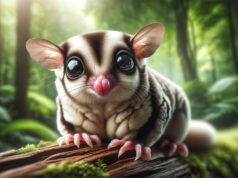
Sugar gliders, known for their captivating eyes and remarkable gliding ability, have emerged as beloved exotic pets around the globe. Understanding sugar glider classification and what family the sugar glider belongs to in the animal kingdom enhances our appreciation of these fascinating creatures and guides responsible pet ownership and conservation efforts. This article delves into the biological classification of sugar gliders, revealing their unique position in the natural world.
Table of Contents
Basic Overview of Sugar Glider Classification
Biological Classification Explained: The system of biological classification organizes living organisms into hierarchical groups based on shared characteristics. This system, starting from the broadest category of ‘Kingdom‘ and narrowing down to ‘Species‘, helps scientists and enthusiasts alike understand the relationships and evolutionary history of different organisms.
Classification of Sugar Gliders in the Animal Kingdom
Sugar Glider Belongs To Kingdom Animalia: Sugar gliders, scientifically named Petaurus breviceps, belong to the Kingdom Animalia. This kingdom encompasses multicellular organisms that are heterotrophic (dependent on other organisms for food) and typically possess the ability to move. Sugar gliders share these fundamental traits, exhibiting a complex level of organization and behavior.
| Domain: | Eukaryota |
| Kingdom: | Animalia |
| Phylum: | Chordata |
| Class: | Mammalia |
| Infraclass: | Marsupialia |
| Order: | Diprotodontia |
| Family: | Petauridae |
| Genus: | Petaurus |
| Species: | Petaurus breviceps |
Class and Order of Sugar Gliders
Within the Mammalian Class: As part of the Class Mammalia, sugar gliders are marsupials, a group distinguished by their unique reproductive process. Female marsupials have a pouch where their young complete their development after birth.
Order Diprotodontia: Sugar gliders fall within the Order Diprotodontia, characterized by certain dental features and a syndactylous condition (fused toes). This order includes kangaroos, koalas, and wombats, along with sugar gliders.
The Family of Sugar Gliders: Petauridae
Characteristics of Petauridae: The Family Petauridae is where sugar gliders find their more immediate relatives. Members of this family are known for their gliding membranes, allowing them to move between trees efficiently. These adaptations point to a shared evolutionary trait among Petauridae members.
Genus and Species of Sugar Gliders
The Genus Petaurus: Sugar gliders belong to the genus Petaurus, a group of flying possums. This genus is characterized by the presence of a gliding membrane (patagium) and a diet primarily consisting of sap and nectar.
Species – Petaurus breviceps: The species Petaurus breviceps, or the common sugar glider, is distinguished by its small size, grey fur, and black facial markings. Their species’ physical adaptability for gliding, such as a flattened tail and elongated limbs, is remarkable.
Unique Traits of Sugar Gliders
Physical Adaptations: The most notable trait of sugar gliders is their gliding membrane, which extends from their forelegs to their hind legs. This adaptation allows them to make controlled glides of over 50 meters, a key survival mechanism in the wild.
Behavioral Characteristics: Sugar gliders are highly social animals, often living in groups in the wild. They are also nocturnal, with heightened senses that aid in nighttime navigation.
Conservation Status
Current Status and Threats: Sugar gliders are currently listed as ‘Least Concern’ by the IUCN. However, habitat destruction and the pet trade pose significant threats to their wild populations.
Conservation Efforts: Conservation initiatives focus on habitat preservation and regulating the pet trade. Educational programs also play a vital role in raising awareness about the species and their natural habitat.
Also Read: Sugar Glider Life Expectancy: How Long Do Sugar Glider Live?
The Role of Classification in Sugar Glider Care
Implications for Pet Owners: Understanding the sugar glider’s classification and natural habits is crucial for providing appropriate care. It helps owners replicate their natural diet, social structure, and environment as closely as possible.
Conservation and Research: Classification aids researchers in understanding the ecological role of sugar gliders and developing conservation strategies.
Conclusion
Sugar gliders, with their unique classification within the family Petauridae, present a fascinating study in marsupial biology. Understanding where they fit in the animal kingdom deepens our appreciation for these creatures and underscores their conservation importance. For pet owners and wildlife enthusiasts alike, this knowledge is vital in ensuring the species’ well-being both in captivity and the wild.
We encourage readers to engage with wildlife conservation efforts and seek out reputable sources when considering a sugar glider as a pet. Sharing your experiences and knowledge can contribute to the collective effort to understand and protect these remarkable animals.









